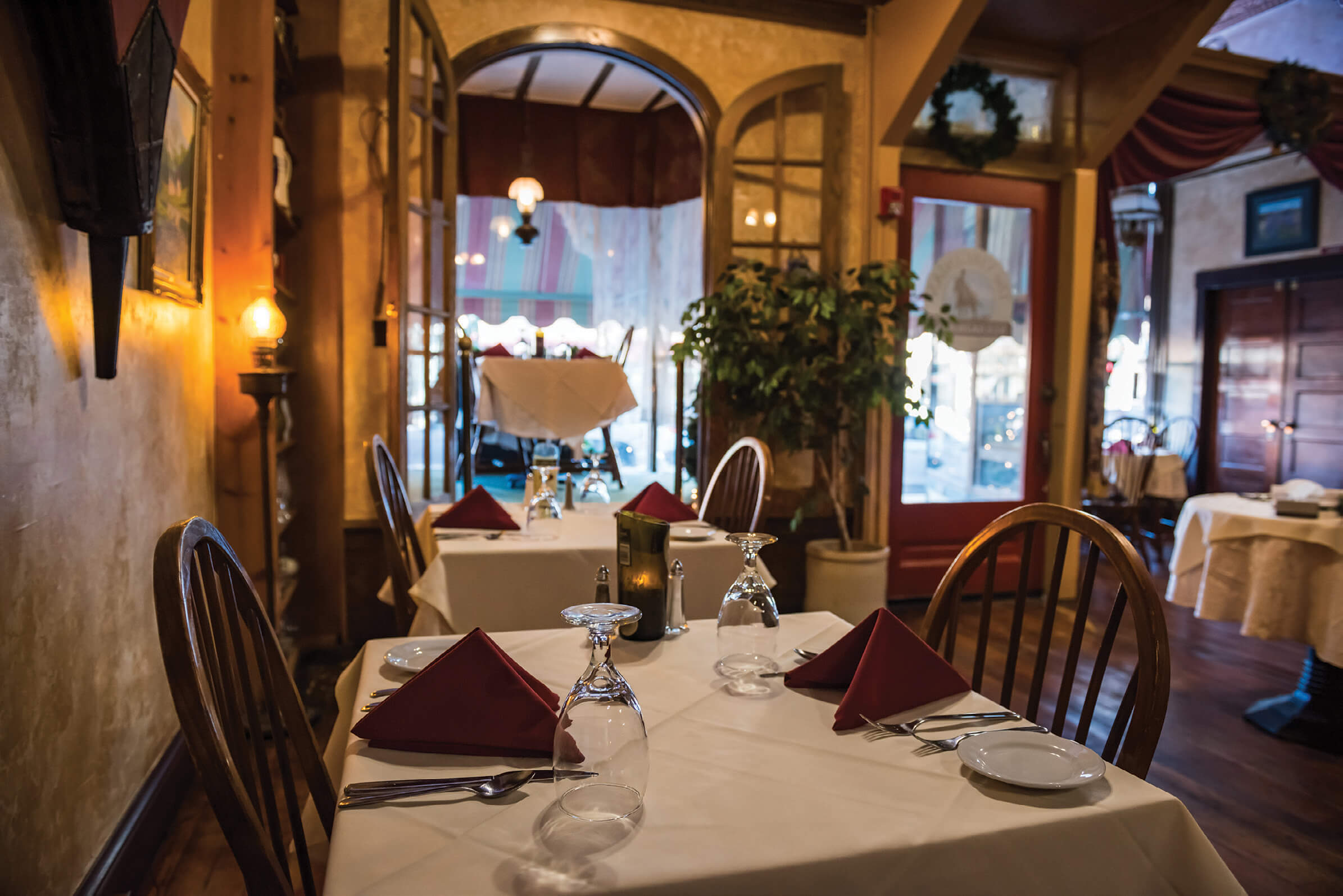
02 Feb Dining Out: The Virginian
The Occidental Hotel started as a couple of tents along Clear Creek, at the foot of Wyoming’s Bighorn Mountains. Charles Buell, a carpenter from Wisconsin, made camp in 1879, just three miles from the new Fort McKinney. As was often the case, an “army town” grew up around the fort and was settled by homesteaders, miners, and the occasional entrepreneur like Buell. The story goes that Buell was building a place along the creek when a passel of miners came down from the Bighorns with gold and asked if they could board with him for a few days. Since Buell was a good cook, he not only housed the men, but fed them well: bacon, eggs, flapjacks, coffee. When they left, the miners shared their gold with Buell in thanks for his generous hospitality. With those flecks of gold, the Occidental was born.
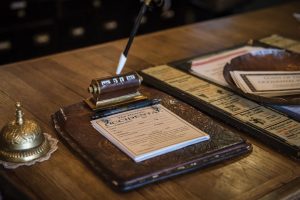
The check-in desk at the Historic Occidental Hotel hasn’t changed much over the years. In fact, the whole first floor is a living museum.
By the fall of 1880, Buell had built a 24- by 28-foot log structure that held a lobby, dining room, kitchen, and six bedrooms. As the most impressive building in the growing army town, “The Ox,” as it came to be known, served not only as a hotel, but also as a stagecoach station, a post office, a saloon, a community gathering place, the town hall, the primary polling place, a makeshift hospital, and the county courthouse. According to Buell family lore, at an 1880 gathering, locals put possible names for the growing town into a hat and the name Buffalo — submitted by a native of Buffalo, New York — was drawn.
From its beginnings, the Occidental was at the heart of everything in Buffalo, Wyoming. Rebuilt with brick and covering an entire city block by 1910, the hotel changed hands a few times over the years and was shuttered from 1984 until 1990, but 144 years after Buell pitched that first tent on Clear Creek, The Ox is still the beating heart of this community.
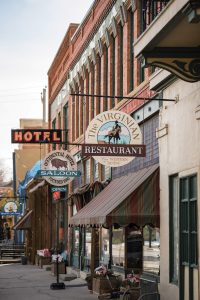
Since 1910, the Occidental, including the hotel, restaurant, saloon, bakery, and café, has taken up an entire city block.
Today, the hotel — complete with 18 rooms and suites — has been immaculately restored to its early 20th-century glory, replete with original woodwork and period antiques. Guests can stay in the rooms where Teddy Roosevelt, Ernest Hemingway, and Calamity Jane hung their hats. The entire first floor is a museum filled with artifacts, photos, and furnishings from the hotel’s early years. Some of the furnishings tie directly to the hotel’s most well-known guests, including the torn sofa that got its holes from the fishing lures President Herbert Hoover was known for carrying in his pocket. There are old guest registers and photographs offering evidence for the presence of such outlaws as Butch Cassidy (who signed under the alias George L. Cassidy, alongside two of his known associates in 1890) and Tom Horn. (Ask to see the 23 bullet holes from shootouts in the saloon.) A collection of books and antique clothing on the second floor is available to guests and open to the public through tours by appointment. For lovers of Old West iconography, it’s hard to imagine a more thrilling place to spend the night.
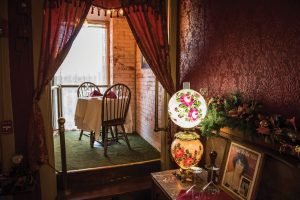
The restaurant’s Rose Room offers a couple of romantic window seats and timeless ambience throughout.
In keeping with the hotel’s long reputation for fine food, The Virginian — named for the novel by Owen Wister, who spent time in the saloon here and perhaps wrote parts of the book in residence — serves up fine Western fare in an elegant Old West setting. Like the hotel, the restaurant has been many things over the years, including a mercantile and dairy barn. The tin ceilings are original, as are the wood floors. Getting to your table “is like walking through history,” says chef Jennifer Johnson, who started working for the hotel seven years ago. A historian by training, Johnson has held almost every job in the hotel. She started as a bartender in the saloon; then worked the front desk; ran the museum, wrote grants, and gave tours; served as hostess; and eventually became the head chef of The Virginian. “I just wanted to bring good food to Wyoming,” she says.
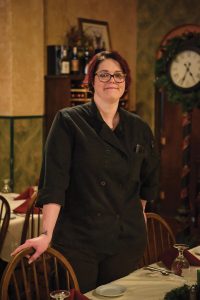
Chef Jennifer Johnson runs The Virginian with her husband Joe. Johnson has worked nearly every job in the building — from bartending and hostessing, to running the museum and manning the front desk — but feeding people her elegant and satisfying takes on Western fare makes her happiest.
And bring it she does. As seems right for this part of cattle country, the menu is heavy on steaks, all of them hand-cut — from flat iron to filet mignon, elk tenderloin and bison to Angus ribeye, which is Johnson’s favorite. But because The Virginian is New West too, the menu also includes salmon and scallops, chicken marsala, salads, and steak gorgonzola pasta, another of Johnson’s favorite recipes to prepare. “I enjoy cooking,” she says. “And I love being able to experiment with specials every week.”
The locals seem to love it, too. “It’s a place for celebrating things,” she says. And, as one walks through either of the two dining rooms — the Rose Room or the Pronghorn, both named by Johnson for the artwork that adorns the historical spaces — it’s easy to imagine the countless celebrations that have happened over the decades in those rooms. There are a couple of romantic window seats, one that was the original entrance to the building more than a century ago. Indeed, tourists flock to the restaurant from summer to fall “to experience history,” Johnson says. History and a perfect Wyoming steak, that is.
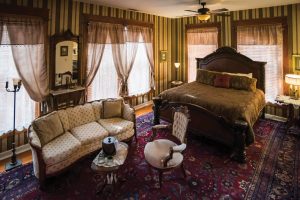
One of eight suites in the Historic Occidental Hotel, the second-story Cloud Peak Suite can be booked as one or two bedrooms, complete with a sitting area fireplace, a small dining area, an oversized bathroom, and a private balcony.
The whole place is special and keeping it that way is a labor of love for the entire staff. Johnson, who started working for owners David and Jackie Stewart when they bought The Ox in 2015, says it probably costs around four times as much money and time to run a business in a historical building. She talks about how they replaced all of the old wiring, and explains what happens to a flat roof in a Wyoming storm. She describes the wallpaper they ordered from England to match what guests would have seen 100 years ago. It’s all worth it though, Johnson says: “There’s no place like it.”
The Virginian is open for dinner from 5 to 9 p.m., Monday through Saturday during the high season, and Wednesday through Saturday during the low season. Reservations are recommended. For more information, visit occidentalwyoming.com.
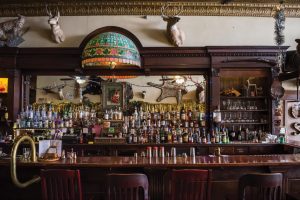
Serving food and spirits daily from the gorgeous 1908 back bar with stained glass accents, the Occidental Saloon has a long and storied history. Want proof? Ask to see the bullet holes in the walls and ceiling.
Carter Walker is the author of several Moon travel guides, including Montana & Wyoming (November 2022) and Yellowstone to Glacier National Park Road Trip (March 2023). She lives on an old homestead in the Horseshoe Hills with her daughters and an ever-growing menagerie of animals.
Born on the banks of the fabled Rock Creek and raised in the foothills of the Bighorn Mountains, Hank Welles has never strayed far from his roots in “Wyotana.” He strives to work and play hard while doing his best to work while others play and play while others work.




No Comments